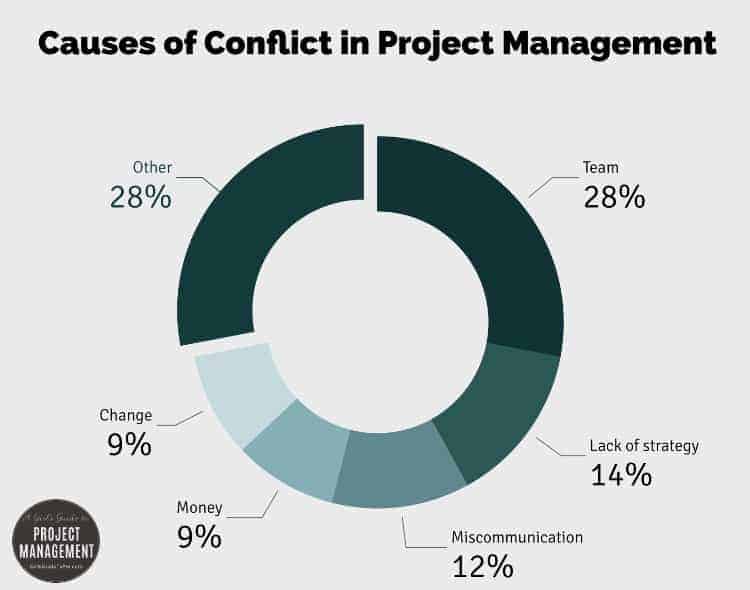How to manage team conflict (& 5 strategies for conflict resolution)
Projects can be a hotbed of conflict. From the difficult stakeholder who wants to undermine the project’s success to a disagreement about a feature of a deliverable, project work lends itself to workplace conflict situations.
And project managers contribute hugely to that because we go out and look for it. We challenge leaders, we talk about risk and what might go wrong and we call people out on poor performance through project monitoring and control.
You could say we go looking for trouble.
That’s part of the job, though. Conflict should be a healthy part of any team’s development, and it’ a good way to challenge requirements and ensure that your business case and plans stand up to scrutiny.
So while you shouldn’t shy away from conflict, it does help to be prepared for it.
In this article, we’ll look at the causes of team conflict on projects, how to identify conflict and resolution strategies so you can all get back to work. If you prefer to watch videos instead of read, skip on to the videos in each section that summarize the article.
What is team conflict?
This is how I like to define conflict:
Conflict happens when two or more people disagree and one of them (at least) decides to make an issue of it.
Team conflict is where there are differences of opinion within the team.
Differences of opinion are not always negative, but typically on a team you want everyone to end up pulling in the same direction. So we need to resolve the differences and get the team aligned to a common goal again.

Conflict during the project lifecycle
First, let’s look at where you get conflict during the project life cycle and who is involved.
Below I’ve also given you some examples of what drives those difficult situations. Then you can be better prepared for the challenges when they come (because they will!).
Project management conflict examples in the Concept Phase
First up, the Concept or Initiation Phase. This is at the start of the project while you are working out exactly what is going to happen.
During this phase there’s a risk of conflict between:
- The sponsor and users, for example about requirements or cost, or around agreeing the problem and the solution
- The sponsor and the project manager, for example around the requirements and how to get there
- The sponsor and portfolio management, for example about business case approval.
In all of these examples you are going to be able to think up your own situations where conflict might arise based on what you see on your own projects. These are just ideas from my own experience and there will be plenty of other moments in a project where people don’t agree.
As we’ve said, that’s normal and not necessarily something to be worried about. In my experience, there are often more conflict points at the beginning of a project, partly because team members are finding their place in the hierarchy of the team and exploring how their contribution matters to the project.
Conflict examples in the Definition Phase
In this phase the project is being fully scoped and planned. There are workshops, facilitated meetings, backlog grooming sessions and plenty of chat between team members — not all of it in agreement!
There’s a chance that you’ll see conflict between:
- The project manager and team leaders, for example due to a difference of opinion about planning, around roles and responsibilities or around assigning risk ownership to people who don’t believe they are accountable for it
- The project manager and sponsor, for example because once the detailed planning is done there may be a need to review scope.
- The project manager and suppliers, for example around commercial agreements.
Again, these are only examples and you’ll probably have examples from your own experience that spring to mind.
Conflict examples in the Development Phase
The Development, Delivery or Execute Phase (whatever you call it where you work) is where the bulk of the work is done and it’s here that you’ll see the most possibility for conflict.
You might not get it — but there is plenty of possibility! Hopefully, if the project is well-defined, with a clear goal and a set of stakeholders who are supportive of the mission, then the chances for conflict are lesser.
In uncertain projects, where there is a highly complex solution, where the solution isn’t known or the team is iterating the solution as they go using
Watch out for sparks between:
- The project manager and sponsor, for example due to changes to scope and at any key decision making point, for example, risk response plans
- The project manager and team, for example around resource or task allocation
- The project manager and team leaders, for example around resource or task allocation
- The project manager and functional managers, for example around resource or task allocation (see a pattern?)
- The project manager and users, for example as a result of quality control and checking.
In this phase you really want to deal with team conflict quickly because your project schedule can start to unravel if you let it go on for too long. There are tips for doing that later in this article: I’ll share the 5 common options for resolving conflict in the team.
Conflict examples in the Handover and Close Phase
You’ve made it to the end of the project and now you’re handing over to business as usual teams and closing the project down. What could go wrong here?
Perhaps more than you were expecting! You’re at risk of project team conflict between:
- The project manager and the users or sponsor, for example at the point of handover of deliverables
- The project manager and the operational team, for example as they might not want to receive the handover or be ready to take responsibility.
Team conflict management should be on your agenda so you can tidy up any lingering awkward situations before you walk away from a project.
You don’t want to leave anyone with a sense that something is unfinished and it will be better for you too, knowing that you’ve done the best job you can to sort out the loose ends.
At any point on the project you could be trying to performance manage a colleague who isn’t making their best contribution. Gets tips for managing a team member with a negative attitude here.
What causes conflict on project teams?
So why do you get all this conflict on project teams? I have mentioned some causes of conflict above, but in 2012 I did some research into this at an event. It wasn’t incredibly scientific, but I asked the people who came to my presentation what caused conflict on their project teams.
The answers, as you would expect, were a mixed bag. A couple of points stood out clearly, and the root of nearly all the potential issues and clashes were unexpectedly to do with people.
We collected responses on sticky notes and there were loads. It was almost as if people couldn’t help themselves but come up with situations where conflict was rife on their projects.

Many types of conflict in teams have their roots in the relationships between team members. The team accounts for over a quarter of all conflict causes. Some of the examples people gave included:
- Lack of clarity about roles
- Personality clashes
- Ego
- Lack of respect.
Take those out, and you’ve hugely reduced the likelihood of conflict on your project team.
Lack of strategic direction and leadership was another biggie, with 14% reporting that was a cause of conflict on their projects. Miscommunication and misunderstandings in the team came in at 12%, followed by budget issues and responses to change both taking 9% of the responses.
The ‘Other’ segment represents nearly 30% of responses and here there were a multitude of themes including:
- Aggressive timescales
- Lack of benefits
- Lack of knowledge
- No project management method or structure to underpin success
- Confused requirements
- The customer’s expectations.
So we know when conflict in project management might happen in the lifecycle, and what causes it. But how do you know what to look for so you know how to identify conflict when it happens?
Identifying conflict in the workplace

“Many people do not allow themselves to see or recognize conflicts in their conversations because they do not know how to resolve conflicts,” says Shawn Kent Hayashi, of The Professional Development Group. “As project managers, we can help facilitate the discussion, as long as our own fears of past problems that have occurred during conflicts hasn’t shut down our awareness that a nagging conflict exists.”
She explains that there are several types of conflict:
- Me with myself
- Me with another
- Between two others, and I am caught in their conflict
- A project team where people are not in agreement and have varying ideas
- Organizational conflict across departments.
When you know where to look, you can spot conflict in all kinds of places!
“If we do not admit an issue we cannot resolve the conflict,” says Shawn. “Instead, we sweep it under the carpet or ‘wear blinders’ as a symptom of feeling fear, not thinking we can handle a conversation to discuss the conflict and create a solution.”
The most important thing, then, for identifying conflict at work, is to be open to the fact that it might be happening.
Still not sure if there is conflict on your project? Try to identify conflicting goals between stakeholders. If you find expectations misaligned, that’s a conflict waiting to happen.
If you acknowledge conflict is possible, even if you know it might put you out of your comfort zone to deal with it, then you will be more open to noticing and doing something about it.
You’ve already spotted it, so you can jump in and help get it resolved now.
How do I deal with conflicting priorities?
One of the most common causes of conflict is conflicting priorities.
Conflicting priorities happen when:
- Where you are juggling multiple demands on your time.
- Where your stakeholders have differing expectations of you and the project.
Stakeholders may have want different things from you and the project, and that needs to be ironed out. You can’t have one stakeholder expecting the deluxe version in blue and another one expecting the budget version in green.
The project can only deliver one option, so those differing expectations need to be aligned.
That could be done by one stakeholder capitulating. The other gets what they want. Or you could have a compromise. There are some other options for team conflict resolution methods below.
Resolve by focusing no consensus
- What are the conflicts? Is it conflicting requirements within the project or is your time under pressure because you are doing too many tasks/projects at the same time.
- How do you see the priorities?
- Who will validate those priorities? Talk to your sponsor, project board, or your manager. They will either validate how you see the priorities, enabling you to focus on what the true priorities are, or reject the way you see them (in which case they should offer alternatives.)
Team conflict resolution: 5 ways to get through disagreements
OK, let’s say there is some conflict on the team. Project management and conflict resolution go hand in hand — being able to manage conflict is a core skill for project managers.
But what does resolving conflict actually look like in practice? Here are some project management conflict resolution strategies. Actually, they will work for non-project conflicts too!
There are also team conflict examples in the sections below so you can see how these scenarios play out in real life.
The Thomas-Kilmann Conflict Mode Instrument
The Thomas-Kilmann conflict mode instrument (TKI) is a way of working out your preferred style for handling conflict (not just at work, but generally we see it used in workplace settings).
It’s a useful tool for understanding a range of options available to you once you’ve identified a conflict situation. You have to deal with it — TKI gives you a selection of ways to do so.
Developed by Thomas and Kilmann (you guessed that, right?) in 1974, it’s a questionnaire that asks you to identify how you naturally react when faced with the opinions or concerns of two people that don’t align.
It’s a way of identifying your own natural reaction and response when you are in a conflict situation with someone.
There are two things I like about the TKI:
- You get a vocabulary that helps you define your default style when facing conflict, but also helps you understand what the other options are.
- You don’t have to do the questionnaire to find the model useful. The basic principles can be understood easily and applied to your project at any time.
The TKI looks at two different aspects of your approach to managing conflict.
- Assertiveness: How far do you take your own concerns at the expense of others’?
- Cooperativeness: How far do you go to satisfy the other person’s concerns?
Basically, the model forces you to think about how far you will go to win and how much it matters to you that other people may have concerns that need to be met.
Tip: Talk to your HR team to find out if they have access to the formal TKI assessment. Can you take it with your team and compare styles?
The next part of the TKI instrument is the five different modes for responding to conflict. These are:
- Competing
- Accommodating
- Avoiding
- Collaborating
- Compromising.
Let’s dive into those options next.
The Avoiding Conflict Mode
Avoiding is where you don’t engage in conflict at all. It’s an unassertive approach, because you aren’t discussing or actively doing anything, and uncooperative, because you aren’t helping the other person either. It’s the ‘do nothing’ approach.
It might sound like it would never work but it can be effective if you use it in moderation — and in the right situations.
Example: Two colleagues are arguing loudly. Their noise is disturbing other people in the open plan office. You talk to them calmly and tell them that when they’ve calmed down — both of them — you can help them work out some next steps. You suggest that one of them cools off in the meeting room, and the other goes to the staff kitchen area.
What’s happened here is that you haven’t fixed the conflict. The team members still have something they need to resolved. You don’t know the details yet, and it is definitely worth finding out! You still need to address the underlying issue.
If you don’t do something, it’s possible the problem gets worse over time.
Project management conflict resolutions strategies you can use that fit into this Avoiding mode:
- Postpone the conversation until there is a better time to have it
- Move away from a threatening situation — hopefully you don’t find yourself in many of these at your workplace!
The Accommodating Conflict Mode
Accommodating is the opposite of Competing (more on that in a minute). This is what happens if you are directed to do something. For example, if your project sponsor directs you to take a certain course of action to handling a risk.
It’s an unassertive response but it shows high cooperation because your personal preferences are overlooked and overridden.
You might think that if you end up in this situation, you’ve ‘lost’ but sometimes it isn’t worth winning.
Example: A project team member checks their annual leave requests with you and you notice that a key task they are scheduled to do clashes with their time off. You’re unhappy about them taking the time off, and they explain that they have already agreed a colleague will take over the work. It’s not worth arguing this point as the work will still get done — so you agree to their leave request.
Be careful how often you use this strategy as if you capitulate too often, people might start to see you as a walkover.
The Competing Conflict Mode
Competing is also called Forcing.
It’s high up on the assertive scale and it’s uncooperative — just as the name suggests!
This is where you force the other person to take on your solution. They ‘lose’.
You can only really take this approach when you have some kind of legitimate power that specifically relates to the situation you’re in. Examples of legitimate power include:
- You are more senior than the other person in the management hierarchy
- You have control of something relevant to the situation, like the budget or resources
- You have expertise relevant to the situation that the other person doesn’t have.
Example: You’re working on a building site and a colleague says they don’t want to wear the health and safety equipment. In this situation, you have to force the team member to comply with the regulations.
Conflict resolution strategies you can use in these situations:
- Telling someone else what to do
- Issuing a written directive that tells someone else what to do.
However, you might not feel that you have ‘resolved’ conflict if you use these strategies. You’ve made a decision and moved a project on, but you’ve probably ruffled some feathers at the same time. Forcing is really only something to use when you really have to.
The Collaborating Conflict Mode
Collaborating. This is an assertive way of resolving problems. It’s also very cooperative.
Neither party tries to avoid the conflict or ‘win’. Instead, you work together to look into the problems and come up with solutions where you both get what you want.
This is often seen as the ‘best’ way to manage conflict, but the ‘best’ way can be any of these. If my young son runs towards a busy road, collaborating isn’t the approach I’m going to use!
All of the conflict resolution strategies can be useful to you in the right situation.
The Compromising Conflict Mode
Finally, compromising. As you’d expect, both sides make concessions so that you can reach an agreement that unlocks the conflict.
It’s different from collaborating because neither party gets exactly what they were hoping for, but at least you reach a position where you can move on.
There are more strategies for managing team conflict in the video below.
Understand your role
Conflict happens at work. But it’s not always your battle to fight.
Think about who is going to feel let down if you step in and are seen to be taking sides. Often, as managers and leaders on project teams — and more broadly in the workplace — we need to be neutral.
Understanding the boundaries of your role as a project manager can help you get the team to a resolution. Basically that means understanding it’s not always your job to resolve conflict.
You can facilitate the conflict resolution, but unless you are one of the parties ‘in’ the conflict — for example, if there is conflict between you and a line manager — then it’s not your role to find the solution.
They own the disagreement. You own the facilitation of the resolution.
Key Takeaways
- Conflict management for project managers is part of the daily engagement with stakeholders and the team.
- Conflict can happen at any point in the project lifecycle.
- It can happen for numerous reasons, often to do with misunderstandings and misaligned expectations.
- There are many ways to resolve conflict at work. Try a few of the techniques mentioned here and arm yourself with some strategies that work for your personal style.
- Deal with conflict as soon as you can to stop it becoming a larger problem.

I’d like to thank the team at Genius Project for sponsoring this article. Genius Project is a fully-featured project management software tool that includes everything you need to support defining, developing and delivering your work successfully with collaboration features to engage your team at every step of the way.
Pin for later reading:


